初三英语Unit4 Wild animals Vocabulary说课教案 牛津英语
- 格式:doc
- 大小:35.50 KB
- 文档页数:2
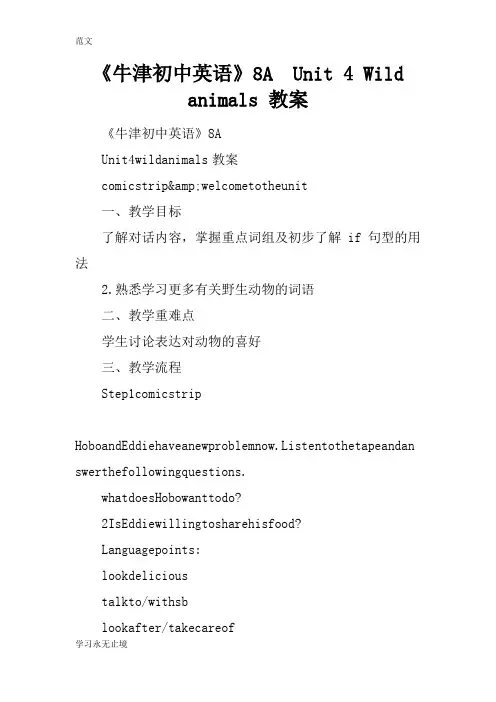
《牛津初中英语》8A Unit 4 Wildanimals 教案《牛津初中英语》8AUnit4wildanimals教案comicstrip&welcometotheunit一、教学目标了解对话内容,掌握重点词组及初步了解if句型的用法2.熟悉学习更多有关野生动物的词语二、教学重难点学生讨论表达对动物的喜好三、教学流程Step1comicstripHoboandEddiehaveanewproblemnow.Listentothetapeandan swerthefollowingquestions.whatdoesHobowanttodo?2IsEddiewillingtosharehisfood?Languagepoints:lookdelicioustalkto/withsblookafter/takecareofAskstudentstopayattentionto‘if’clausesStep2VocabulariesAskstudentstolookatthepicturesandlearnnewwordsabout wildanimals.beardolphingiantpandakangaroosquirreltigerStep3GuessinggamesLetstudentsplayaguessinggame.onestudentdescribesand theotherguess‘whatanimalisit?’Step4makeasurveypletethesurveyformonP59 Step5DiscussionA:whichanimaldoyoulikebest?B:Ilike……best.A:why?B:Becausetheyare…...A:whichanimaldoyoulikeleast?B:Ilike……least.A:why?B:Becausetheyare…...Step6HomeworkRememberallthewordsaboutwildanimalsandtrytodescribe them.教后记:《牛津初中英语》8AUnit4wildanimalsReading1一教学目标.知识目标.)知识并运用本课时的四会单词。
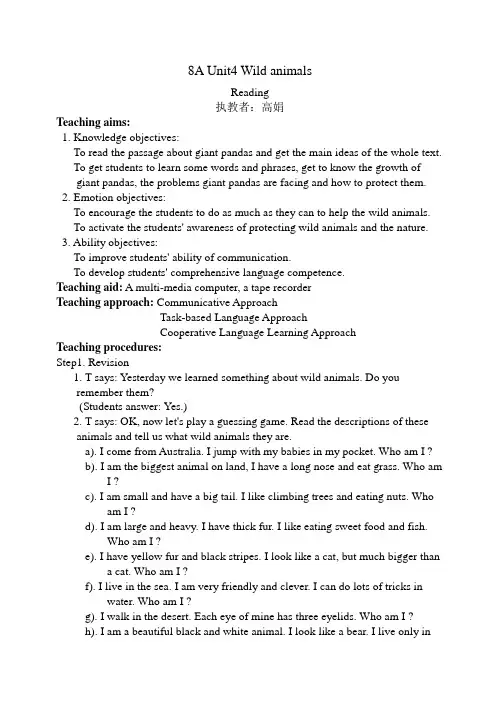
8A Unit4 Wild animalsReading执教者:高娟Teaching aims:1. Knowledge objectives:To read the passage about giant pandas and get the main ideas of the whole text.To get students to learn some words and phrases, get to know the growth ofgiant pandas, the problems giant pandas are facing and how to protect them. 2. Emotion objectives:To encourage the students to do as much as they can to help the wild animals.To activate the students' awareness of protecting wild animals and the nature. 3. Ability objectives:To improve students' ability of communication.To develop students' comprehensive language competence.Teaching aid: A multi-media computer, a tape recorderTeaching approach: Communicative ApproachTask-based Language ApproachCooperative Language Learning ApproachTeaching procedures:Step1. Revision1. T says: Yesterday we learned something about wild animals. Do youremember them?(Students answer: Yes.)2. T says: OK, now let's play a guessing game. Read the descriptions of theseanimals and tell us what wild animals they are.a). I come from Australia. I jump with my babies in my pocket. Who am I ?b). I am the biggest animal on land, I have a long nose and eat grass. Who amI ?c). I am small and have a big tail. I like climbing trees and eating nuts. Whoam I ?d). I am large and heavy. I have thick fur. I like eating sweet food and fish.Who am I ?e). I have yellow fur and black stripes. I look like a cat, but much bigger thana cat. Who am I ?f). I live in the sea. I am very friendly and clever. I can do lots of tricks inwater. Who am I ?g). I walk in the desert. Each eye of mine has three eyelids. Who am I ?h). I am a beautiful black and white animal. I look like a bear. I live only inChina . My greatest hope is to take a colour photo. Who am I? (When the students say out the answers, show the pictures on the screen.)Step2. Presentation1. Ask : Do you like wild animals? (Yes/ No.)Which is your favourite wild animal?Why do you like it/them?Students answer the questions.Teacher says: Do you know Miss Gao's favourite wild animal?--Giant pandas.I think they are very lovely. They are friendly to people and won't hurt people.Show a picture of a giant panda. Do you know anything about giant pandas?2.Teach new words by asking some questions about giant pandas.a). Where do giant pandas live?In the wild / In the forest/ In giant panda reserves..b). What do giant pandas eat?They eat bamboo shoots and leaves.3. Ask: But when a giant panda was born , can they eat bamboo shoots orleaves?(No.)What do they eat when they are at birth? And what are baby pandas like atbirth?Tsays: Today we have a chance to learn more about a giant panda.Step3. Fast-ReadingPlease read the passage as quickly as you can to find out the name of thegiant panda.Step4. Listening and scanningListen to the tape and then try to complete the chart.Age The growth of Xi Wang1 day weigh 100g10 days look like a white mouse4 months weigh 10kg, start to go outside her home6 months start to eat bamboo shoots and leaves8 months not a small baby any more,grow into a healthy young giantpanda,weigh 35kg20 months have to look after herselfRead the paragraphs1-3 and then let the Ss make the sentences with the words to introduce the growth of Xi Wang.Have a look at the pictures of the growth of Xi Wang and complete Part on Page61. Let the students introduce the growth of Xi Wang with their own words.Step5. Presentation1. Tsays: Do you think giant pandas are lovely? (Yes). But they are in danger. It'svery difficult for them to live in the wild. What problems are they facing?2. Listen to the tape and find out the problems they are facing. Problems ActionsIf hunters__________, they ___________. make giant panda reserves biggerIf farmers__________,giant pandas__________.build more reservesIf people___________, they ____________. encourage farmers to leave the giant panda reserves3. Let the students read the three paragraphs again and then say out the problems giant pandas are facing without looking at the books.4. Tsays: We have known the problems giant pandas are facing. Can we do something to help? OK, read the rest part of the passage and complete the chart above.5. Students say out the actions with their own words.Step6. Whole-readigRead the whole passage by themselves.Step7. An interviewLet one student stand in front of the class to act as Xi Wang. Others are all interviewers. Ask "Xi Wang"the questions they are interested in.Step8. DiscussionHold a further discussion: Why do we call it Xi Wang? Can you find another name for her?Step9. ClassworkFinish an exercise paper.。
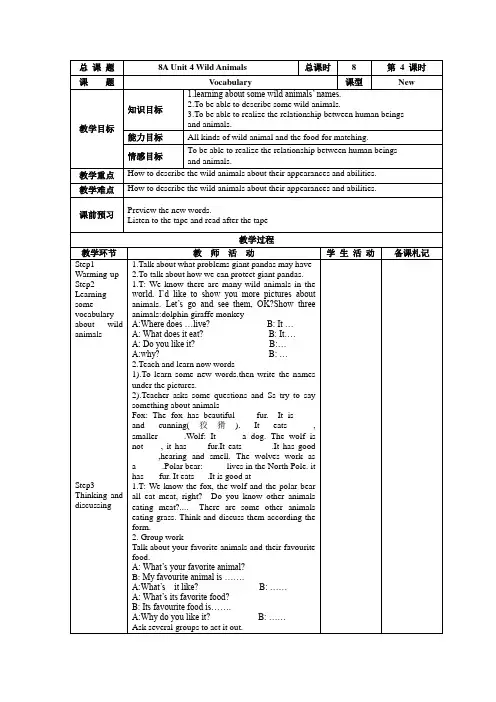
学案教学目标1.识别并掌握各种野生动物的名称。
2.将各种野生动物与其食物进行匹配。
一、单项选择。
( ) 1. Do you hear that there are still some people living __________?A. in wildB. on wildC. in the wildD. on the wild( ) 2. __________ did the baby panda ____ when he was born?A. How; looksB. How; is likeC. What; lookD. What; like ( ) 3. There are _____ and _______ in the zoo.A. wolfs; foxesB. wolves; foxsC. wolves; foxesD. wolfs; foxs ( ) 4. People often kill animals __________. What a pity!A. for funnyB. with funnyC. with funD. for fun( )5. I hear there ________ an English film tonight.A. will beB. will haveC. is going to haveD. are going to be ( ) 6. ____ only live in China.A. TigersB. SquirrelsC. Giant pandasD. Kangaroos( ) 7. The old man is sure of living ____ one hundred years old.A. onB. atC. up toD. up( ) 8. People should make giant panda reserves bigger ____. A. protect them B. to protect themC. hunt them easilyD. to kill them easily( ) 9. My teddy bear is red, so this blue one must be ____.A. else someone’sB. someone else’sC. other one’sD. some other’s( ) 10. There are ____ giant pandas in Africa.A. fewB. a fewC. littleD. a little( ) 11. You’d better ____ the wild animals.A. not hurtB. not to h urtC. don’t hurtD. not hurting( ) 12. Be quick, ____ we’ll be late for the meeting.A. andB. butC. soD. or( ) 13. If I ____ free next Sunday, I ____ to the farm with you.A. will be; will goB. am; will goC. am; goD. will be; go( ) 14. His parents went there with a friend of ____.A. themB. theirsC. theyD. themselves二、用方框中所给词的正确形式完成短文。
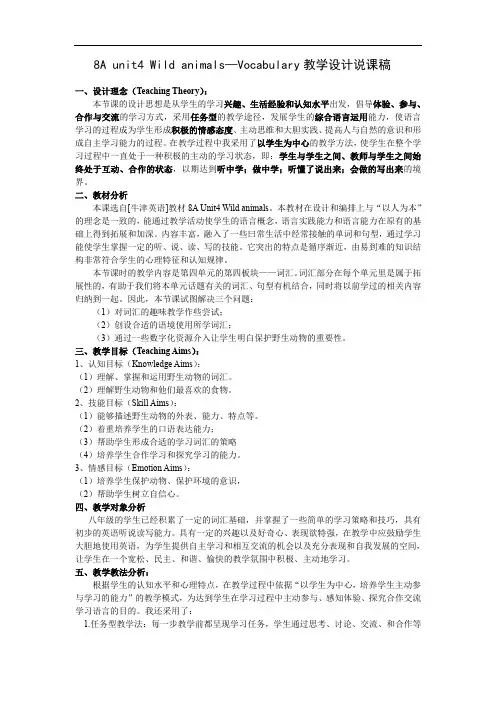
8A unit4 Wild animals—Vocabulary教学设计说课稿一、设计理念(Teaching Theory):本节课的设计思想是从学生的学习兴趣、生活经验和认知水平出发,倡导体验、参与、合作与交流的学习方式,采用任务型的教学途径,发展学生的综合语言运用能力,使语言学习的过程成为学生形成积极的情感态度、主动思维和大胆实践、提高人与自然的意识和形成自主学习能力的过程。
在教学过程中我采用了以学生为中心的教学方法,使学生在整个学习过程中一直处于一种积极的主动的学习状态,即:学生与学生之间、教师与学生之间始终处于互动、合作的状态,以期达到听中学;做中学;听懂了说出来;会做的写出来的境界。
二、教材分析本课选自[牛津英语]教材8A Unit4 Wild animals。
本教材在设计和编排上与“以人为本”的理念是一致的,能通过教学活动使学生的语言概念,语言实践能力和语言能力在原有的基础上得到拓展和加深。
内容丰富,融入了一些曰常生活中经常接触的单词和句型,通过学习能使学生掌握一定的听、说、读、写的技能。
它突出的特点是循序渐近,由易到难的知识结构非常符合学生的心理特征和认知规律。
本节课时的教学内容是第四单元的第四板块——词汇。
词汇部分在每个单元里是属于拓展性的,有助于我们将本单元话题有关的词汇、句型有机结合,同时将以前学过的相关内容归纳到一起。
因此,本节课试图解决三个问题:(1)对词汇的趣味教学作些尝试;(2)创设合适的语境使用所学词汇;(3)通过一些数字化资源介入让学生明白保护野生动物的重要性。
三、教学目标(Teaching Aims):1、认知目标(Knowledge Aims):(1)理解、掌握和运用野生动物的词汇。
(2)理解野生动物和他们最喜欢的食物。
2、技能目标(Skill Aims):(1)能够描述野生动物的外表、能力、特点等。
(2)着重培养学生的口语表达能力;(3)帮助学生形成合适的学习词汇的策略(4)培养学生合作学习和探究学习的能力。
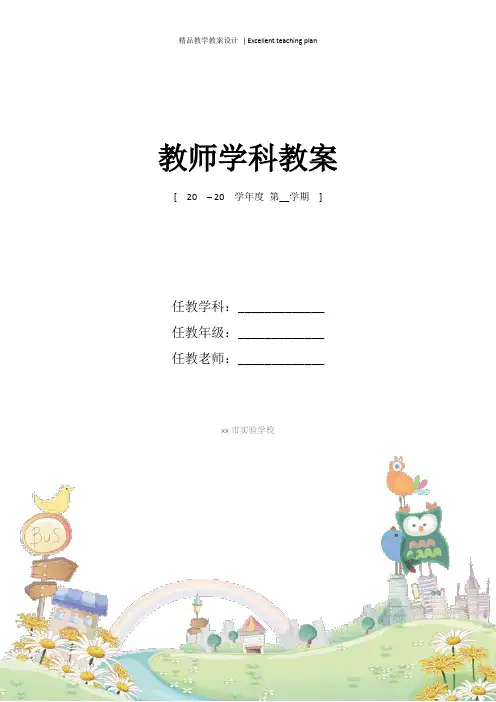
教师学科教案[ 20 – 20 学年度第__学期]任教学科:_____________任教年级:_____________任教老师:_____________xx市实验学校《牛津初中英语》8A Unit 4 Wild animalsComic strip& Welcome to the unit一、教学目标1 了解对话内容,掌握重点词组及初步了解if句型的用法2. 熟悉学习更多有关野生动物的词语二、教学重难点学生讨论表达对动物的喜好三、教学流程Step1 Comic stripHobo and Eddie have a new problem now. Listen to the tape and answer the following questions.1 What does Hobo want to do?2 Is Eddie willing to share his food?Language points:look delicioustalk to/with sblook after/ take care ofAsk students to pay attention to‘if’clausesStep2 VocabulariesAsk students to look at the pictures and learn new words about wild animals. bear dolphin giant panda kangaroo squirrel tigerStep3 Guessing gamesLet students paly a guessing gane to engage them.One student describes and th e other guess ‘What animal is it?’Step 4 Make a surveyAsk stuents to work in pairs. Complete the survey form on P59Step5 DiscussionA: Which animal do you like best?B: I like ……best.A: Why?B: Because they are …...A: Which animal do you like least?B: I like…… least.A: Why?B: Because they are …...Step 6 HomeworkRemember all the words about wild animals and try to describe them.《牛津初中英语》8A Unit 4 Wild animals Reading1一教学目标1.知识目标1.)知识并运用本课时的四会单词。
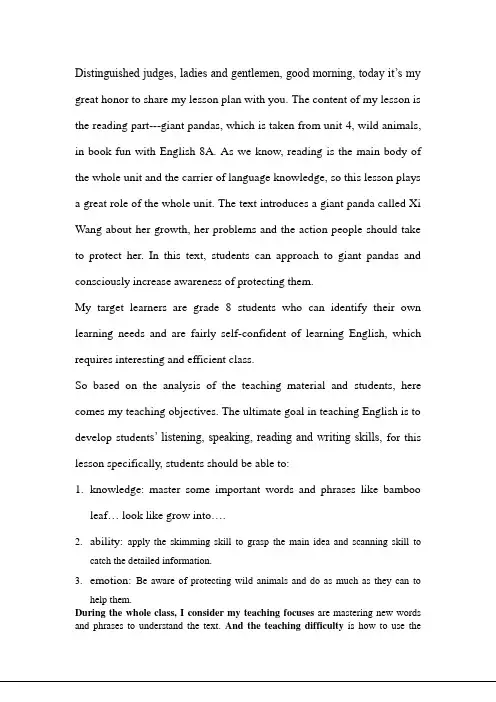
Distinguished judges, ladies and gentlemen, good morning, today it’s my great honor to share my lesson plan with you. The content of my lesson is the reading part---giant pandas, which is taken from unit 4, wild animals, in book fun with English 8A. As we know, reading is the main body of the whole unit and the carrier of language knowledge, so this lesson plays a great role of the whole unit. The text introduces a giant panda called Xi Wang about her growth, her problems and the action people should take to protect her. In this text, students can approach to giant pandas and consciously increase awareness of protecting them.My target learners are grade 8 students who can identify their own learning needs and are fairly self-confident of learning English, which requires interesting and efficient class.So based on the analysis of the teaching material and students, here comes my teaching objectives. The ultimate goal in teaching English is to develop student s’ listening, speaking, reading and writing skills, for this lesson specifically, students should be able to:1.knowledge: master some important words and phrases like bambooleaf… look like grow into….2.ability: apply the skimming skill to grasp the main idea and scanning skill tocatch the detailed information.3.emotion: Be aware of protecting wild animals and do as much as they can tohelp them.During the whole class, I consider my teaching focuses are mastering new words and phrases to understand the text. And the teaching difficulty is how to use theknowledge they learnt to describe Xi Wang.For breaking through the teaching focuses and difficulties, I’d prefer to adopt task-based, audio-visual and communicative teaching methods.As for the teaching aids, multimedia computer and the blackboard will be used to make my class more vivid and convenient.Now, let’s come to the teaching procedures including 5 steps, warming up and lead-in, pre-reading ,while-reading , post-reading and extension.Step 1:warming up and lead-inI will play a video about wild animals for the students. I’ll say: Boys and girls, are you familiar with wild animals? Let’s watch a video and check it. After watching, please tell me what animals do you know and which one do you like best? After video, I will say: Now try your best to talk sth, if you can talk for more than 30 seconds, then you’ll be given a star, only 4 of you can get the chance, so hands up! (the purpose of this stage is to attract students’ interest and create lively atmosphere.) Then, I’ll say: Well done, shall we play a guessing game? Now, start.No.1, it’s the king of animal world and has yellow fur and black stripes on its body. What’s this? Yes, it’s a tiger.No.2, it jumps with its baby in pocket, what’s this? Good, it’s a kangaroo.The last one, look at the screen, what’s this? (give a picture of panda) Yeah, it’s a giant panda! (give giant pandas on the screen)In this way, old words have been reviewed and the topic has been led in.Step 2: pre-readingI’ll say: Do you know where do giant pandas live? Yes, they live in forest( write forest on the blackboard). What do they eat? They eat bamboo shoots and leaves(write it on the blackboard) In this way, present new words like hunter ,kill and survive….Step 3: while-readingSkim: I will ask them to skim the text and then answer two questions1.What’s the name of the panda? What does it mean?2.What will happen to giant pandas if we do nothing?Scan:(the purpose of this stage helps students know the growth of Xi Wang) Task 2: Now, suppose you are a member of the animal protection club, can you help us fill in the blank about Xi Wang’s problems and actions we can takeThrough these 2 tasks, students may have a deeper understanding about Xi Wang’s growth and her current situation.Step 4: Post-readingNow read the text again and try to retell it, you can retell it with the order of the growth of Xi Wang , the problems she meets and actions peoplecan take to protect them.Step 5 ExtensionHave a discussion. All the students will think about a question: Why do we call her Xi Wang? Find another name for her. Students can discuss in groups and then someone can show their opinions on behalf of their group.Homework。
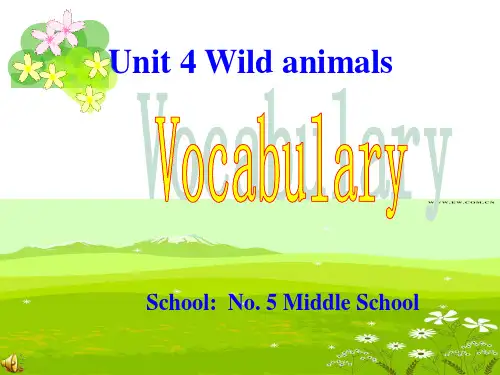

英语:Unit 4《Wild animals》Vocabulary教案(译林牛津版八年级上)一、教学目标1. To learn about some wild animals’ names.2. To learn about these wild animals’ appearance , food and living areas.3. To be able to make short dialogues about wild animals with their partners.4. To know the importance of protecting wild animals.二、教学重点难点1. Some wild animals’ names, food and living areas.2. How to describe the wild animals about their appearances and abilities.3. According to what they learnt in the class, make short dialogues and introduce the wild animals.三、教学过程Teaching procedures:Step One : Leading-inWarm-up 1.Leading-in by the theme song of animal world.2. T: When hearing the music, what do you think of? S. Wild animals.T: Today we’ll go into the world of wild animals.Step Two: RevisionRevise the wild animals they have learnt in this unit by a guessing game. (Teach the word: stripe.)Step Three: Learning the names of some wild animals.1. T: In the forest , there will be a big party. Many wild animals are coming. Do you know them?Show the pictures of the wild animals and teach the students how to read them.2. Ask the students try to remember the places of the pictures and the names of the wild animals. Then play another guessing games about these.3. T: You know the names of these wild animals. Can you say anything special about them?Teacher describe one wild animal as an example. Help the students try to describe these wild animals’ special abilities and appearances. (Teach: turtle shell, smell, hearing, foxy, hump, eyelid)Step Four : Learning about food and living areas of these wild animals.1.T: Do you want to learn more about these wild animals? Do you know their food and living areas? Forexample, what do foxes eat?Show some pictures of insects and teach insect.2.Books open. Make students talk about part B animals’ food in page63 in pairs. Then check the answers inpairs in this way: Ask: What do camels feed on? Answer: Camels feed on grass and tree leaves.3.Show some pictures about wild animals’ living areas. (Teach: desert, wetland, grassland, North Pole)Step Five : Task 11.Tell the students the wild animals are having the party and some reporter are coming, too. Ask them to make adialogue between the reporter and the wild animals. Ask them to use the information and words teacher taught.Make the students work in pairs, in three and in four. ( Give them headgears of three animals: a tortoise, a zebra and a wolf)2.Several minutes later, ask four groups to act out the dialogues.Step Seven : Task 21. T: Audience like the programs very much. They want to learn more about the wild animals. Can you introducethe other wild animals like Zhao Zhongxiang? Then teacher should introduce one animal as an example.Ask the students to begin it like this: Hello, everyone. This is Animal World. I’m … Today I’ll introduce you a wild animal---…2. Give the students several minutes. And ask them to come to the front and talk about the last five wild animals. Step Eight : Ending the class.1.T: After watching the program, more people are interested in wild animals.Show some pictures of some ferocity animals: a tiger, a lion, a bear and a crocodile..T: How do you feel when you see these pictures? Look at their sharp teeth and paws. ( Teach: dangerous, endangered, in danger)2.Show some pictures about people killing wild animals. Make the students think about two questions afterclass:1)What problems do wild animals have?2)How can we protect wild animals?。
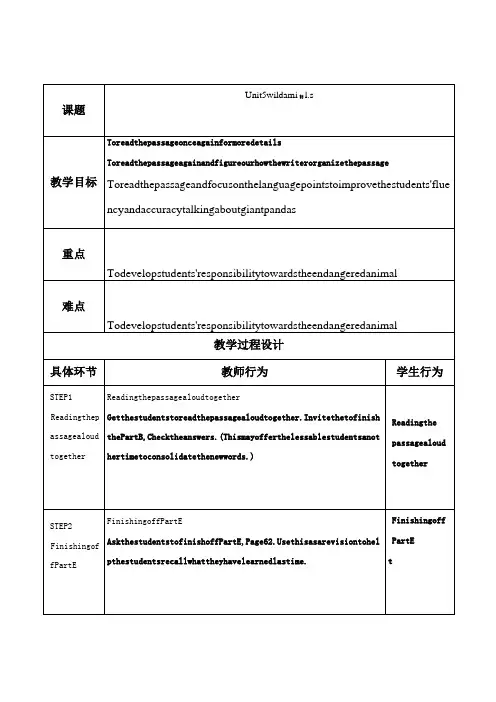
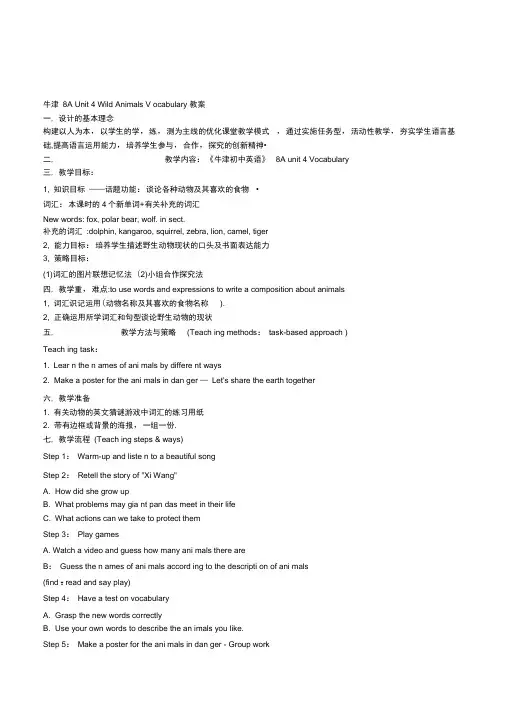
牛津8A Unit 4 Wild Animals V ocabulary 教案一,设计的基本理念构建以人为本,以学生的学,练,测为主线的优化课堂教学模式,通过实施任务型,活动性教学,夯实学生语言基础,提高语言运用能力,培养学生参与,合作,探究的创新精神•二,教学内容:《牛津初中英语》8A unit 4 Vocabulary三,教学目标:1, 知识目标——话题功能:谈论各种动物及其喜欢的食物•词汇:本课时的4个新单词+有关补充的词汇New words: fox, polar bear, wolf. in sect.补充的词汇:dolphin, kangaroo, squirrel, zebra, lion, camel, tiger2, 能力目标:培养学生描述野生动物现状的口头及书面表达能力3, 策略目标:(1)词汇的图片联想记忆法(2)小组合作探究法四,教学重,难点:to use words and expressions to write a composition about animals1, 词汇识记运用(动物名称及其喜欢的食物名称).2, 正确运用所学词汇和句型谈论野生动物的现状五,教学方法与策略(Teach ing methods: task-based approach )Teach ing task:1. Lear n the n ames of ani mals by differe nt ways2. Make a poster for the ani mals in dan ger —Let's share the earth together六,教学准备1. 有关动物的英文猜谜游戏中词汇的练习用纸2. 带有边框或背景的海报,一组一份.七,教学流程(Teach ing steps & ways)Step 1: Warm-up and liste n to a beautiful songStep 2: Retell the story of "Xi Wang"A. How did she grow upB. What problems may gia nt pan das meet in their lifeC. What actions can we take to protect themStep 3: Play gamesA. Watch a video and guess how many ani mals there areB: Guess the n ames of ani mals accord ing to the descripti on of ani mals(find T read and say play)Step 4: Have a test on vocabularyA. Grasp the new words correctlyB. Use your own words to describe the an imals you like.Step 5: Make a poster for the ani mals in dan ger - Group workStep 6: HomeworkA. Review the content of this less onB. Find more information about wild animals on the Internet, and write a letter to the chairperson of the Wild An imals Club for protecti ng wild an imals.野生动物保护网----- 中国野生动植物保护司------ www.wildlife-pla .c n卧龙国家级自然保护区------ www.chi nawol on 八,板书设计Tigers are in dan gerappeara neeBig and strong ,bright eyes yellow fur, black stripes, beautifulcharacterLive as a family un til baby tigers are 2-3 years old Usually live aloneabilitycan run very fastGood at hun ti ng other ani malsfoodan imalsdan gersHun ters hunt them for their fur and bon es(to make medici ne)Wolves are in dan gerappeara neeNot very big , grey furcharacterFrie ndly towards each other, ofte n work as a team, n ever attack people, Don't kill them for fun abilityRun very fastVery good eyesight, heari ng and smellfoodAni mals in sects sn ails vegetablesdan gersloss of livi ng areas , no home , no food牛津英语8A Un it 4 Vocabulary说课稿本课是牛津英语译林版8A第4单元第4课时Vocabulary.词汇(Vocabulary)部分主要任务是围绕本单元话题呈现与本课话题有关的新词语,为学生运用语言提供更大的空间,方便学生开展后面的学习活动,同时,按词义将同一类别的单词集中学习,有利于提高学生单词学习的效率,快速扩大词汇量.在词汇教学部分教师根据实际情况对该部分的词汇进行添加或删减,并且指导学生有效学习单词,扩大词汇量,防止学生走死记硬背的老路.牛津英语教材以话题为主线,任务为主导,辅以功能和结构等项目,有效培养学生综合运用英语的能力.本单元围绕wild animal这个话题展开,符合"创造和谐社会,共享完美人生”的社会要求.在本单元教学活动的前期,教者结合"SARS"事件教育学生保护野生动物,这样即贴近学生的生活实际又培养学生”保护动物,由我做起"的主人翁意识.通过前面3课时的教学,学生们已经大致了解世界上各种动物的外貌(appearanee)及生活习性(abilities)等,懂得了世界因为各种动物而多姿多彩.本课的中心任务就是在了解’希望"的成长过程及列举她在以后的野外生活中将遇到的危险的基础上,通过体验,参与,合作,交流和探究等方式,教授"野生动物的名称及其食物",并为本单元的中心任务"写一段拯救濒危野生动物的陈述性小短文"做很好的铺垫,以达到保护动物的学习目的.在整个备课过程中,在充分挖掘教材重点难点的基础上,以拓展与培养学生的学习能力与语言交际能力为目的组织教学活动,让学生真正成为教学的主体.整个教学环节紧密结合"参与式教学”模式倡导的”让学生参与教学的全过程的教学理念,在集体备课的前提下,精心设计导学提纲,让学生知道在上课前应该预习,有目的的做好预习工作,寻疑问难•本课的课前预习主要要求学生在掌握单词的基础上朗读课文,找出一些有用的句型为第二天的口头作文及书面表达打下基础•在课堂教学设计上,鼓励学生进行合作学习,取长补短,充分突出学生的主体地位和教师的主导作用相结合的教学理念•本课主要通过词汇教学要求学生用已掌握的词汇和句型进行简单的会话,体现英语的语用价值•在处理词汇教学过程中,我采用由易到难的教学方法,先复习"The story of Xi Wan g",让学生根据课文回答几个简单的问题,然后通过图片提示或给出关键词等不同的形式,复述希望的故事,引出成长的不易,及生命的崇高•接着通过猜谜游戏,以图片的形式生动形象的呈现各种野生动物的生活场景,以旧带新的方式组织词汇教学,即检测了学生课前预习的效果又有效的激发学生的学习热情•接着以一曲《熊猫咪咪》引出本课的另一个教学重点一一野生动物的食物,再通过编对话的形式将本课的新授词汇和信息呈现出来•最后结合课文中所教授的句型,短时间准备后进行一项保护濒危动物口头陈述•并鼓励学生们利用网络查找更多有关野生动物的知识,让他们以小组为单位,合作完成一幅海报,让学生在做中学,学中用,并同过成果展示来获得成就感,激发他们学习英语的更高热情.。
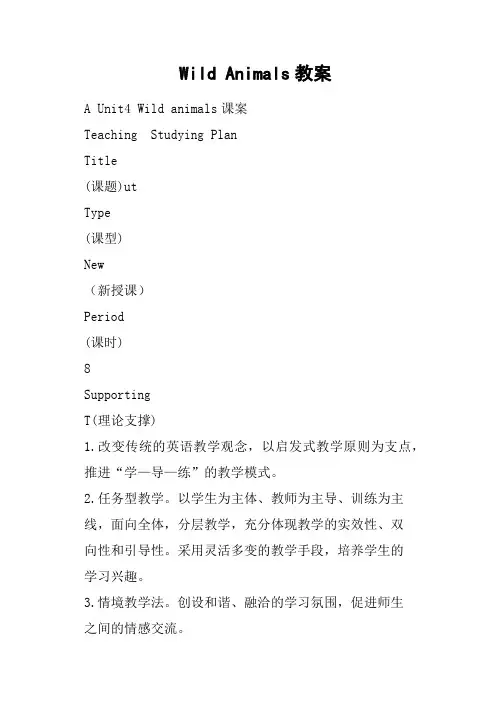
Wild Animals教案A Unit4 Wild animals课案Teaching Studying PlanTitle(课题)utType(课型)New(新授课)Period(课时)8SupportingT(理论支撑)1.改变传统的英语教学观念,以启发式教学原则为支点,推进“学—导—练”的教学模式。
2.任务型教学。
以学生为主体、教师为主导、训练为主线,面向全体,分层教学,充分体现教学的实效性、双向性和引导性。
采用灵活多变的教学手段,培养学生的学习兴趣。
3.情境教学法。
创设和谐、融洽的学习氛围,促进师生之间的情感交流。
4.合作学习。
提倡合作与交流,增强集体意识和荣誉感。
注重学生的能力培养,力争课堂的优质高效。
Aims Demands(教学目标)A: Knowledge (语言知识)To mausagant words and phrases.To know the usage of “if” conditionalB: Language skill (语言技能)To learn to talk about wild animals.C: Feeling (情感态度)To knowag wild animaland difficulties(教学重、难点)Using conditionalalk about possible situaGiving reasons with “because” “because of”.Writing aTeaching Methods(教学方法)Task-based ApproachSituational Teaching MethodAids:课前准备(教具、活动准备等)Blackboard; computer; OHP (overhead);ures教学设计课前延伸1. Seaation about wild animals.2. Fxart.让学生通过课前自学,小组内的团结合作解决预习中的一些问题,为上课做准备Teaching Plan(授课计划)Studying Plan(学习计划)Aims(设计意图)课内探究学Warm up1. Preview work(answers.)2. Describing and guessing. (What kind of animal is it?)复习热身,通过游戏的形式检查预习情况,激发学生兴趣,复习巩固并为新课的学习做铺垫。
精选教课教课设计设计| Excellent teaching plan教师学科教课设计[ 20–20学年度第__学期]任教课科: _____________任教年级: _____________任教老师: _____________xx市实验学校《牛津初中英》 8A Unit 4 Wild animalsComic strip& Welcome to the unit一、教课目1 认识内容,掌握要点及初步认识if 句型的用法2.熟习学更多相关野生物的二、教课重点学生表达物的爱好三、教课流程Step1 Comic stripHobo and Eddie have a new problem now. Listen to the tape and answer the following questions.1 What does Hobo want to do?2 Is Eddie willing to share his food?Language points:look delicioustalk to/with sblook after/ take care ofAsk students to pay attention to ‘ if ’ clausesStep2 VocabulariesAsk students to look at the pictures and learn new words about wild animals. bear dolphin giant panda kangaroo squirrel tigerStep3 Guessing gamesLet students paly a guessing gane to engage them.One student describes and th e other guess ‘ Whatanimal is it? ’Step 4 Make a surveyAsk stuents to work in pairs. Complete the survey form on P59Step5 DiscussionA:Which animal do you like best?B:I like ⋯⋯best.A:Why?B:Because they are ⋯ ...A:Which animal do you like least?B:I like ⋯⋯ least.A: Why?B:Because they are ⋯ ...Step 6 HomeworkRemember all the words about wild animals and try to describe them.《牛津初中英》 8A Unit 4 Wild animals Reading1 一教课目1.知目1.)知并运用本的四会。
UNIT FOUR PART ONE: TEACHING DESIGN第一部分:教学设计Unit Objectives●To talk about possible situations and possible results●To enlarge the vocabulary about wild animals●To use factual information to support their opinions on wild animals ●To learn to take the responsibility to protect wild animals●To introduce the topic and main task of the unit. Help the studentsto focus on ‘Wild animals’●To learn more about wild animals and then express their preference ●To think of ways to help the endangered animalsTeaching proceduresSTEP 1 Answering the questionTell the students that I have got a very difficult question to answer. And I would like to ask you to answer the question, too. Show the question on the board. And get the students to discuss about it.B. You and your friend are on an island with nothing to eat. However you have only one hamburger.If you don’t eat, you will die.If your friend doesn’t eat, he/she will dieIf you share the hamburger with your friends, you will both die.Will you eat it by yourself or give it to your mother, or share it with your friend?Get the students to talk about Question A first. (It may not be very difficult for the students to answer.) Then show the students Question B. Give the students a few minutes to discuss about the question. (For more able students, encourage them to speak out their questions, too. ) STEP 2 Listening and answeringTell the students that Eddie is now facing such a problem. Get the students to listen to the tape and then answer the following questions:1. Who has food? Eddie has food.2. Is he going to share his food with his master / e-dog?No, he isn’t going to share his food with Hobo.STEP 3 Reading the dialogue together or in rolesGet the students to read the dialogue together or in roles. Ask the students to practice and remember the dialogue and then act it out. STEP 4 Finishing the following exercisesGet the students to focus on possible actions and possible results of the dialogue. Then get them to finish the following exercises.Possible Actions Possible resultsI don’t ha ve food, I ___ (die).I die, no one _________ (look) after you.you eat my food, I _________ (not talk) to you.Hobo doesn’t have food, he ____ (die).Eddie dies, no one _________ (look) after Hobo.Hob o eats Eddie’s food, Eddie __________ (not talk) to Hobo.STEP 5 Getting to know about wild animalsMan is now having the same problem, too. Many animals share the same homeland with us. However, man has taken their food and their homes away. Ask, ‘Do y ou think we should do something to help?’ (Yes.)Wild animals are our friends. It is important to protect wild animals. (Write the sentence on the board then get the students to read it aloud.)‘Let’s check how much you know about wild animals. Do you know them?’ Show the pictures of the animals.to speak out what they know about the animals, focusing on the appearance and something special about it.STEP 6 Play a guessing gamePlay a guessing game. Write the names on pieces of papers and then invite some of the more able students to choose and say something of the animals (To make it easier, ask the students to use the first person). The other students should listen carefully and guess what animal it is.Bear:I am strong. Sometimes, I eat people. But if I find the people died, I don’t eat them. Who am I?Kangaroo:I have a pocket. My baby sleeps in my pocket. Who am I? Squirrel: I have a long and soft tail. I live in the tree. Who am I? Giant Panda:I have black eyes and four black paws. I like eating bamboo shoots(竹笋). I am very lovely. Who am I?Dolphin: I like swimming. I can do different kinds of swimming shows. Many people bring their children to watch my shows. Who am I? Tiger: I am the king of the animals. I look like a cat but I’m bigger than a cat. Usually, I have yellow fur and black stripes. Who am I? STEP 7 Talking the animal they like best/leastGet the students to talk the animal they like best/least. If possible, encourage them to mention some simple reasons.STEP 8 HomeworkFind more information about wild animals and finish the exercises.PERIOD 2: READING ITeaching Goals●To develop the ability to guess general meaning form context●To get to know the problems that the giant pandas are facing and thenstart to think of way to protect the pandas●To get to know the importance of animal protectingTeaching ProceduresSTEP 1 Talking about the animalsGet the students to talk about the animals once again. Play the guessing game. Write something about a kind of animal on pieces of paper. Invite some of the students to choose and read about the animal and the others try to guess what animal it is.Guess what they are?1. They are large and heavy. They have thick fur. They like eating sweet food and fish If they are hungry, they also eat man.are lovely and clever animals in the sea. They like swimming in groups. They are very friendly to people.come from Australia. They jump with their babies in their special packets.4. They have yellow fur with black stripes. They are the kings of the forest.5. They are the biggest animals on land. They eat grass.6. They are small animals with big tails. They like climbing trees and eating nuts.7. They live in China. They like eating bamboo shoots and leaves very much. STEP 2 Teaching the words ‘hunter’, ‘survive’ and ‘reserve’As students come to ‘giant pandas’, get the students to talk about whatever they know about giant pandas. As they mention there are few giant pandas now, teach the words ‘hunter’, ‘survive’ and ‘reserve’. To arouse the students’ interest, get the students to guess how heavy giant pandas are at birth. The teacher can also give them some choices to choose from. . 2 jin, 500 grams, 100 grams and 1 kilogram)STEP 3 Telling the students the right answerTell the students the right answer. (They may be amazed at the information.)Say ‘I have some pictures here. They show how the baby grows into a giant panda. Can you put them into the right order?’Show them the following pictures and ask them to put them into the right order.STEP 4 Listening to the first part of the passageTell the students, ‘Millie has f ound a report about giant pandas. Let’s read it and learn more about the animal. But first let’s listen to the first part of the passage and answer the following questions.’Who is Xi Wang? (A baby panda.)How old was Xi Wang when the writer first saw her? (10 days old.) What did Xi Wang look like? (A small white mouse.) What does “Xi Wang” mean in English? (Hope.)STEP 5 Filling in the following tableSay ‘So it’s really amazing that the baby panda is so small. Do you want to know how it grows into a giant panda? Let’s open your books and read the passage.’ Get the students to read the passage and fill in theGet the students to finish Part C: the growth of Xi Wang. Look at the pictures and get the students to read the sentences here loudly. This will once again consolidate the students’ understanding of Xi Wang’s growth.STEP 7 Reading and finding out the problemSay ‘Are pandas lovely? (Yes.) However, they are now in danger. It ishard for them to survive in the wild. (Write the sentence on the board.)They are facing a lot of problems. Can you find them out?’ Get the students to read and find out the problem and what people did toHunters, farmers and some people did something bad to giant pandas. Get the students to say something to them.Hunters you shouldn’t kill giant pandas for their fur. AND SO ON. Get the students to finish Part D, Page 62. Check the answers.STEP 9 DiscussionDiscussion:A s a m i d d l e s c h o o l s t u d e n t,c a n y o u t h i n k o f s o m e g o o d i d e a s t o p r o t e c t p a n d a s?STEP 10 Homework: Read the passage and finish off the exercises in the books.PERIOD 3: READING IITeaching Goals●To read the passage once again for more details●To read the passage again and figure our how the writer organize thepassage●To read the passage and focus on the language points to improve thestudents’ fluency and accu racy talking about giant pandas●To d evelop students’ responsibilit y towards the endangered animal Teaching ProceduresSTEP 1 Reading the passage aloud togetherGet the students to read the passage aloud together. Invite them to finish the Part B, Check the answers. (This may offer the less able students another time to consolidate the new words.)STEP 2 Finishing off Part EAsk the students to finish off Part E, Page 62. Use this as a revision to help the students recall what they have learned last time.STEP 3 Working out the answersGet the students to read the passage together once again and then divide the class into groups of 4-5. Ask them to work out the answer to the following question ‘How many parts are there in the passage.’Give the students enough time to talk about it. And then invite some ofthem to express their personal opinions. (Students should be encouraged to speak out what they think.)Part I: The growth of Xi Wang(Line 1- Line 14) (weight and food)Part II: Giant pandas are in danger?(Line 15- Line 29)A: Why are they in danger?(Line 15-21)B: How to protect them?(Line 22-Line 29)STEP 4 Finishing the following exercisesGet the student to talk about Part I. Invite them to talk about the growth of Xi Wang by finishing the following exercises:•When Xi Wang was born, she w________ just 100 grams.•When she was only 10 days old, she l________ like a white mouse. •When she was 4 months ol d, she w________ about 10 kilograms and s___________ to go outside her home.•When she was 6 months old, she b________ to eat bamboo shoots and leaves. When she was 12 months old, she g_________ into a healthy young giant panda and w__________ 35 kilograms.•When she was 20 months old, she s_________ to look after herself. Then get the students to analyze the sentences: the when-clauses in each sentence give us a past time, so the main clauses use Simple Past Tense. (Students may come to the conclusion through observation.) Then get the student to underline such sentences in the passage.STEP 5 Finding them out‘During the growth of Xi Wang, Xi Wang had many ‘first-times’ Can you find them out.’ Use the following exercises to help students.started _________(go) outside her home for the first time.began _________ (eat) bamboo shoots and leaves.started _________(look) after herself.In this way, the teacher directs the students attention to the use of ‘to’-infinitives after ‘start’ and ‘begin’.STEP 6 Rewriting sentencesSay ‘Sadly, it is very difficult for giant pandas to survive in the wild.’ and write the sentence on the board. Then try to rewrite the sentence into the following sentences.‘It is dangerous for giant pandas to live on in the wild.’ ‘They are in danger.’These are some very important sentence patterns in the passage. Also it is necessary for the teacher to point out that ‘live on’ has a similar meaning with ‘survive’. This may also help the students to understand that we can u se ‘be dangerous’ or ‘be in danger’ to talk about a similar situation.STEP 7 Finding out that why they are in dangerGet the students to find out that why they are in danger. To make the task easier, the teacher can show the following before hand.If hunters _________(catch) a giant panda, they _________ (kill) it for its fur.If the farmers __________(cut) down trees and forests, giant pandas _______ (have) nowhere to live.If people __________ (find) baby pandas alone, they ________(take) them away.As a result, the students’ attention will be easily drawn to the use of ‘if’-clauses. Guide the students to focus on the tense of the subordinate- clauses and main clauses. (I think it is OK for some teachers to use ‘主将从现’ to make summary here. At least i t may help the students to remember this phenomenon.)Explain the phrases here ‘kill…for…’, ‘cut down’, ‘have nowhere to live’ ‘find sb. adj’ and ‘take…away’.STEP 8 Talking about the actions people take to protect the pandasSay ‘If we do nothing, soon t here will be no giant pandas in the world.’ and then get them to talk about the actions people take to protect the pandas. We must take the following actions to protect them. We can make giant panda reserves bigger. • We can build more reserves . • We can encourage farmers to leave the giant panda reservesDirect students’ attention to the use of ‘make sb. adj.’ and ‘encourage sb. to do sth.’ . If time permits, give more examples. STEP 9 Reading though the whole passage againGet the students to read though the whole passage again, focusing on the different language points.STEP 10 More exercises about the language pointsDo more exercises about the language points to check.looks _____________(health).Tom was born, he ___________(weigh) 6 jin.should encourage him ___________(help) his good friend.ask the ___________(hunt) not to hunt the animals.it snows tomorrow, the primary school students _______(stay) at home. many pandas are in ________(dangerous)years _____(late), he became a famous reporter.giant panda likes eating bamboo ____ (shoot) and ____(leaf) very much. STEP 11 Do some translation workLinda 五岁时第一次来中国。
江苏地区初三英语Unit4 Wild animals Vocabulary说课教案Bianchen Middle School Liu XiaofengToday I want to talk about the fourth unit of Wild Animals, Vocabuary 8A Oxford English .1.The Analysis of the textbook , including the contents , the teaching aims , the Focus and the difficulties2.The teaching methods3.The design of the teaching procedure and the class activities4.Evaluation and ReflectionI: The Analysis / / of the textbook1). the contentsThe part of the Vocabulary in the fourth unit startes the topic according to the animals It is a training in listening, speaking, reading and writing ability of students,To make the students learn to observe and to take an interest in the animals so that they can pay attention to their living.2)The teaching aims (the knowledge , the abilities and the emotions )The aims of the knowledge : to master the different names of the animalsThe aims of the abilities : to improve the abilities of hearing speaking , writing and reading.The aims of the emotion : improve their love for the animals in order to raise the consciousness of the student's protection of the wild animal3) The teaching points and the difficulitiesThe points of this lesson; to master the words such as fox , polar ,bear , wolf and insectThe difficulties of this lesson: the training of the language expressionsII. The teaching methods and the waysTeaching the students by the five teaching steps gradually to emphasize the contents . The teacher is to act the guide and the students as an actor to do the activities .In class we can use the modern teaching equipments to make the class interesting and lively .III. Teaching procedure and the aims of the designI)Revision1)Show the picture of Page 55, saying , “boys and girls , do you know these animals ? Name themtogether ,please.”2)Ask the students questions, saying, “ Which one do you like best ? Why ? ” ( ask four studentsto answer )3)Point to the panda, saying , “Look at the giant panda. It’s our national animal. It’s my favourite .How much do you know about it ? ” (ask the six students to answer )II)Lead in1)Ask the students : Do you want to see some other animals ? 2)Show the picture of Page 59, asking : What are their names?Then teach the new words such as fox , polar, bear and wolfIII. Practice1)Complete the following the missing vowels (Omit)2)Show the pictures in the right order to make the students tell the names of the animals (sayingtogether)3)Play guessing games :One student shouts like an animal or make an action and the other studentsguess the name of the animalIV. Practice1)Show the bamboo shoots , fish ,fruit ,grass , insects , leaves and the vegetables in turn , asking :What can you see?Teach the word insect2)Ask questions like that: Which animal likes eating bamboo shoots ? (Ask the students to answerthe full sentence)3)Ask : Which one do you like best ? Why ?V. WritingTeacher: I like all of them . The world are so beautiful because of them . Now please think about these questions and write your answers down .To show the two questions:1)What would happen if they disappeared from the world ?2)What should we do to protect them ?If the students can’t finish the work in class, ask them to finish it after class.。
江苏地区初三英语Unit4 Wild animals Vocabulary说课教案
Bianchen Middle School Liu Xiaofeng
Today I want to talk about the fourth unit of Wild Animals, Vocabuary 8A Oxford English .
1.The Analysis of the textbook , including the contents , the teaching aims ,the Focus and the difficulties
2.The teaching methods
3.The design of the teaching procedure and the class activities
4.Evaluation and Reflection
I: The Analysis / / of the textbook
1). the contents
The part of the Vocabulary in the fourth unit startes the topic according to the animals It is a training in listening, speaking, reading and writing ability of students,
To make the students learn to observe and to take an interest in the animals so that they can pay attention to their living.
2)The teaching aims (the knowledge , the abilities and the emotions )
The aims of the knowledge : to master the different names of the animals The aims of the abilities : to improve the abilities of hearing speaking ,writing and reading.
The aims of the emotion : improve their love for the animals in order to raise the consciousness of the student's protection of the wild animal
3) The teaching points and the difficulities
The points of this lesson; to master the words such as fox , polar ,bear , wolf and insect
The difficulties of this lesson: the training of the language expressions
II. The teaching methods and the ways
Teaching the students by the five teaching steps gradually to emphasize the contents . The teacher is to act the guide and the students as an actor to do the activities .
In class we can use the modern teaching equipments to make the class interesting and lively .
III. Teaching procedure and the aims of the design
I)Revision
1)Show the picture of Page 55, saying ,“boys and girls , do you know these
animals ? Name them together ,please.”
2)Ask the students questions, saying,“Which one do you like best ? Why ? ”
( ask four students to answer )
3)Point to the panda, saying ,“Look at the giant panda. It’s our national
animal. It’s my favourite . How much do you know about it ? ” (ask the six students to answer )
II)Lead in
1)Ask the students : Do you want to see some other animals ?
2)Show the picture of Page 59, asking : What are their names?
Then teach the new words such as fox , polar, bear and wolf
III. Practice
1)Complete the following the missing vowels (Omit)
2)Show the pictures in the right order to make the students tell the names
of the animals (saying together)
3)Play guessing games :One student shouts like an animal or make an action
and the other students guess the name of the animal
IV. Practice
1)Show the bamboo shoots , fish ,fruit ,grass , insects , leaves and
the vegetables in turn , asking : What can you see?
Teach the word insect
2)Ask questions like that: Which animal likes eating bamboo shoots ? (Ask
the students to answer the full sentence)
3)Ask : Which one do you like best ? Why ?
V. Writing
Teacher: I like all of them . The world are so beautiful because of them . Now please think about these questions and write your answers down .
To show the two questions:
1)What would happen if they disappeared from the world ?
2)What should we do to protect them ?
If the students can’t finish the work in class, ask them to finish it after class.。